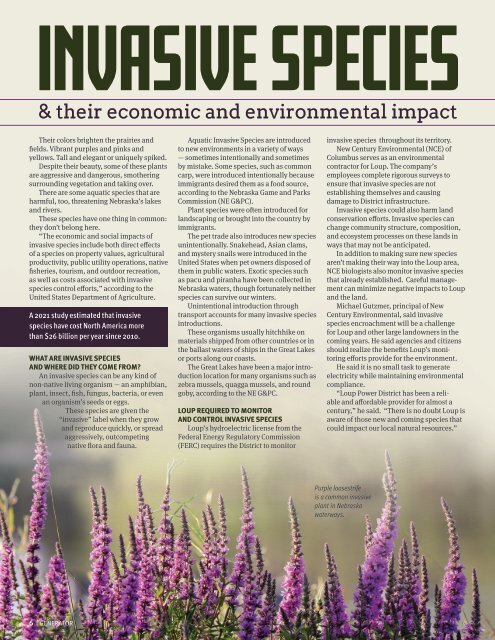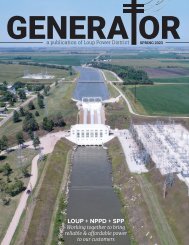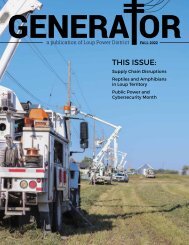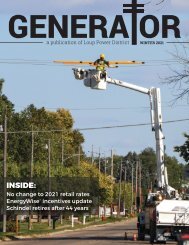Loup Generator — Winter 2022
Learn more about the invasive species in Nebraska and what you can do if you spot them. The 2022 list of financial incentives available to customers who make energy-efficient upgrades. Also in this issue, Mini-Splits 101: an introduction for homeowners.
Learn more about the invasive species in Nebraska and what you can do if you spot them. The 2022 list of financial incentives available to customers who make energy-efficient upgrades. Also in this issue, Mini-Splits 101: an introduction for homeowners.
You also want an ePaper? Increase the reach of your titles
YUMPU automatically turns print PDFs into web optimized ePapers that Google loves.
INVASIVE SPECIES<br />
& their economic and environmental impact<br />
Their colors brighten the prairies and<br />
fields. Vibrant purples and pinks and<br />
yellows. Tall and elegant or uniquely spiked.<br />
Despite their beauty, some of these plants<br />
are aggressive and dangerous, smothering<br />
surrounding vegetation and taking over.<br />
There are some aquatic species that are<br />
harmful, too, threatening Nebraska’s lakes<br />
and rivers.<br />
These species have one thing in common:<br />
they don’t belong here.<br />
“The economic and social impacts of<br />
invasive species include both direct effects<br />
of a species on property values, agricultural<br />
productivity, public utility operations, native<br />
fisheries, tourism, and outdoor recreation,<br />
as well as costs associated with invasive<br />
species control efforts,” according to the<br />
United States Department of Agriculture.<br />
A 2021 study estimated that invasive<br />
species have cost North America more<br />
than $26 billion per year since 2010.<br />
WHAT ARE INVASIVE SPECIES<br />
AND WHERE DID THEY COME FROM?<br />
An invasive species can be any kind of<br />
non-native living organism <strong>—</strong> an amphibian,<br />
plant, insect, fish, fungus, bacteria, or even<br />
an organism’s seeds or eggs.<br />
These species are given the<br />
“invasive” label when they grow<br />
and reproduce quickly, or spread<br />
aggressively, outcompeting<br />
native flora and fauna.<br />
Aquatic Invasive Species are introduced<br />
to new environments in a variety of ways<br />
<strong>—</strong> sometimes intentionally and sometimes<br />
by mistake. Some species, such as common<br />
carp, were introduced intentionally because<br />
immigrants desired them as a food source,<br />
according to the Nebraska Game and Parks<br />
Commission (NE G&PC).<br />
Plant species were often introduced for<br />
landscaping or brought into the country by<br />
immigrants.<br />
The pet trade also introduces new species<br />
unintentionally. Snakehead, Asian clams,<br />
and mystery snails were introduced in the<br />
United States when pet owners disposed of<br />
them in public waters. Exotic species such<br />
as pacu and piranha have been collected in<br />
Nebraska waters, though fortunately neither<br />
species can survive our winters.<br />
Unintentional introduction through<br />
transport accounts for many invasive species<br />
introductions.<br />
These organisms usually hitchhike on<br />
materials shipped from other countries or in<br />
the ballast waters of ships in the Great Lakes<br />
or ports along our coasts.<br />
The Great Lakes have been a major introduction<br />
location for many organisms such as<br />
zebra mussels, quagga mussels, and round<br />
goby, according to the NE G&PC.<br />
LOUP REQUIRED TO MONITOR<br />
AND CONTROL INVASIVE SPECIES<br />
<strong>Loup</strong>’s hydroelectric license from the<br />
Federal Energy Regulatory Commission<br />
(FERC) requires the District to monitor<br />
invasive species throughout its territory.<br />
New Century Environmental (NCE) of<br />
Columbus serves as an environmental<br />
contractor for <strong>Loup</strong>. The company’s<br />
employees complete rigorous surveys to<br />
ensure that invasive species are not<br />
establishing themselves and causing<br />
damage to District infrastructure.<br />
Invasive species could also harm land<br />
conservation efforts. Invasive species can<br />
change community structure, composition,<br />
and ecosystem processes on these lands in<br />
ways that may not be anticipated.<br />
In addition to making sure new species<br />
aren’t making their way into the <strong>Loup</strong> area,<br />
NCE biologists also monitor invasive species<br />
that already established. Careful management<br />
can minimize negative impacts to <strong>Loup</strong><br />
and the land.<br />
Michael Gutzmer, principal of New<br />
Century Environmental, said invasive<br />
species encroachment will be a challenge<br />
for <strong>Loup</strong> and other large landowners in the<br />
coming years. He said agencies and citizens<br />
should realize the benefits <strong>Loup</strong>’s monitoring<br />
efforts provide for the environment.<br />
He said it is no small task to generate<br />
electricity while maintaining environmental<br />
compliance.<br />
“<strong>Loup</strong> Power District has been a reliable<br />
and affordable provider for almost a<br />
century,” he said. “There is no doubt <strong>Loup</strong> is<br />
aware of those new and coming species that<br />
could impact our local natural resources.”<br />
Purple loosestrife<br />
is a common invasive<br />
plant in Nebraska<br />
waterways.<br />
6 | GENERATOR
















